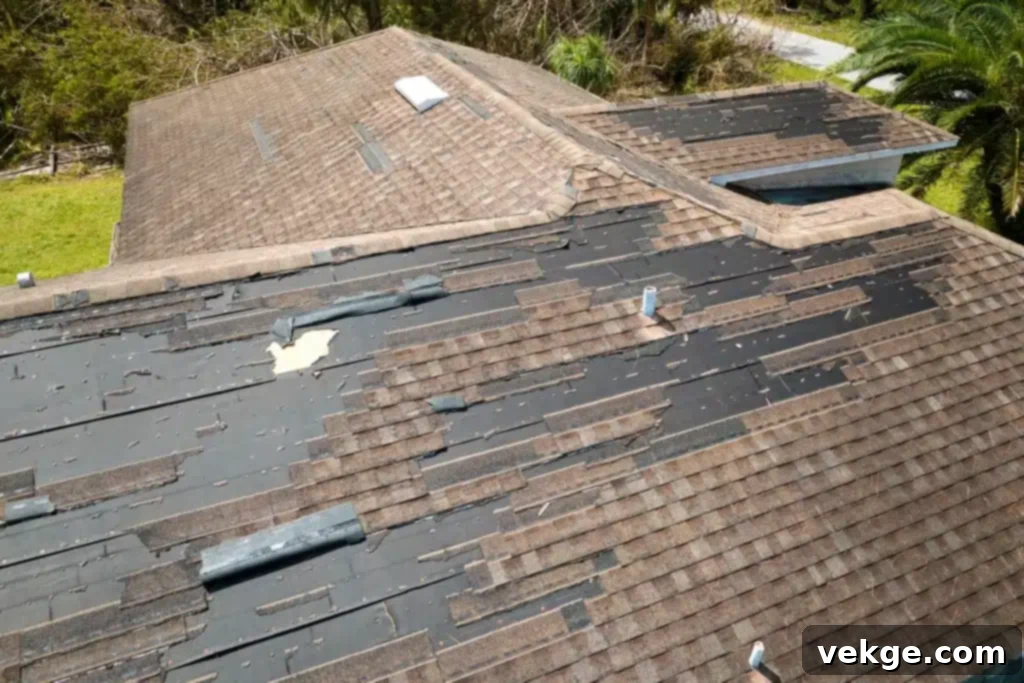Roof Damage Claims: Understanding Critical Deadlines & Maximizing Your Coverage
When unexpected roof damage strikes, homeowners often face immediate concerns about repairs and the associated costs. While the structural integrity of your home is paramount, understanding the intricate timelines involved in filing an insurance claim is equally crucial. Insurance companies establish specific deadlines for reporting damage and initiating a claim, and missing these can have severe financial repercussions, potentially leading to a denied claim and leaving you to bear the full cost of repairs.
These time limitations are not universal; they can vary significantly based on your individual insurance policy, the type of insurance provider, the nature of the damage, and the specific state laws governing insurance practices. For instance, a claim for hurricane damage might have a longer reporting window compared to a claim for standard wind or hail damage. Grasping these nuances is fundamental for every homeowner to ensure they remain eligible for insurance coverage when their roof sustains damage, safeguarding their most valuable asset.
Filing your roof damage claim within the designated time frame is your pathway to recovering the necessary funds for roof repair or even full replacement. Generally, insurers stipulate that claims be reported promptly – often within one year of the incident, or even sooner depending on policy specifics. This promptness is not merely a suggestion; it’s a contractual obligation that helps insurers assess the damage accurately and prevent further deterioration that could complicate the claim.
However, it’s vital to recognize that these reporting periods are not set in stone. Circumstances like catastrophic events (e.g., major hurricanes) may trigger extensions, while other, less severe incidents might have stricter, shorter deadlines. Every claim undergoes meticulous scrutiny, with insurers examining the timeline of the reported damage in relation to the policy’s detailed requirements. Any discrepancies or undue delays can raise red flags and jeopardize your claim’s success.
The ramifications of failing to adhere to these critical time limits for filing a roof damage claim can be profound. The most significant consequence is often the outright denial of your claim, meaning you would receive no financial assistance from your insurer. This underscores the urgency for policyholders to take immediate, decisive action after damage occurs. Documenting the damage comprehensively, securing the property from further harm, and contacting your insurance provider without delay are essential first steps to commence the claims process effectively.
Strict adherence to these deadlines is not just a procedural formality; it’s a protective measure for your financial well-being. It safeguards your ability to receive the necessary funds for repairs, thereby preserving the structural integrity, safety, and market value of your property. Ignoring these timelines can transform a manageable situation into a significant financial burden, making proactive awareness and swift action indispensable.
Understanding the Complex Landscape of Roof Damage Claim Deadlines

Navigating the process of filing a roof damage claim requires a thorough understanding of the specific time constraints that apply. These limitations are primarily dictated by two key factors: the terms and conditions outlined in your individual insurance policy and the overarching state laws governing property damage claims.
1. Deciphering Your Insurance Policy: The First Line of Defense
Your insurance policy is a legally binding contract that details your coverage, responsibilities, and the insurer’s obligations. Most policies explicitly define a specific window within which homeowners are required to report roof damage after its occurrence or discovery. This crucial deadline, often found on your policy’s declaration page or within the “Conditions” section, typically ranges from 30 to 60 days following the damage. However, some policies might demand even quicker reporting. It is paramount for homeowners to actively review their policy documents to pinpoint this claim reporting deadline. Filing your claim promptly within this specified period is not merely a recommendation; it’s a critical prerequisite to ensure your eligibility for coverage and avoid potential disputes or claim denials.
Beyond reporting deadlines, your policy will also detail other time-sensitive requirements, such as the timeframe for submitting a “Proof of Loss” statement, providing repair estimates, or responding to requests for additional information. Familiarizing yourself with these obligations from the outset can prevent delays and strengthen your claim.
2. State-Specific Statutes of Limitations: Legal Backstops
In addition to policy-specific deadlines, state laws impose a Statute of Limitations on property damage claims. These statutes dictate the maximum period within which a legal lawsuit can be filed, often distinct from the insurer’s internal reporting deadlines. For example, in states like Florida, homeowners generally have up to four years to file a lawsuit for property damage. This statutory period can become critically important if you find yourself in a dispute with your insurance company over the claim’s outcome, such as a lowball offer or an outright denial.
While you must report the damage to your insurer within your policy’s timeframe, the state’s statute of limitations provides a longer window for legal action if a resolution isn’t reached. If negotiations with your insurer reach a stalemate, or if you believe your claim has been unfairly handled or denied, retaining legal counsel, such as a Fort Lauderdale roof damage attorney, becomes essential. They can help you understand these legal timelines and represent your interests effectively within the state’s legal framework.
3. Varied Claim Restrictions Based on Damage Type
Insurance providers often differentiate their filing limits and coverage based on the specific type and cause of roof damage. Understanding these distinctions is vital:
- Hail/Wind Damage: Claims related to damage from hail or strong winds typically require reporting within one year of the storm event. Delays can make it difficult to prove the damage was recent and not due to older, unreported incidents.
- Hurricane Damage: Due to the widespread and often catastrophic nature of hurricanes, many states and insurers may extend the filing period, sometimes up to three years post-event. This extended window acknowledges the immense challenges homeowners face after such disasters.
- Sudden, Accidental Damage (e.g., Falling Tree): These claims often fall under the “prompt reporting” clause, similar to hail/wind, usually within 30-60 days of the incident.
- Wear and Tear/Lack of Maintenance: It is crucial to note that damage resulting from general wear and tear, aging, or inadequate maintenance is almost universally not covered by standard homeowners’ insurance policies. Insurers classify these as preventable issues and maintenance responsibilities of the homeowner, not sudden, accidental events.
- Water Damage (Leaks): If a leak is sudden and accidental (e.g., from a storm), it may be covered. However, if it’s due to long-term neglect, poor maintenance, or faulty construction, it is likely excluded. The reporting timeframe would typically align with other sudden damage.
Navigating the Claims Process: Immediate Steps and Professional Guidance
When dealing with roof damage claims, especially concerning the intricacies of legal and policy deadlines, property owners must act swiftly and strategically. Seeking professional advice is often invaluable to ensure you navigate the claims process effectively and secure the compensation you’re entitled to.
Immediate Actions Post-Damage: A Critical Checklist
The moments immediately following roof damage are crucial. Your actions during this time can significantly impact the success of your claim:
- Prioritize Safety: Ensure your family’s safety first. If the damage is severe, evacuate the premises.
- Prevent Further Damage: Take reasonable steps to mitigate further damage. This might involve temporarily covering a hole with a tarp. Keep receipts for any materials purchased for these emergency repairs, as these costs are often reimbursable.
- Document Everything: This is arguably the most vital step. Take extensive photos and videos of the damage from multiple angles, both close-up and wide shots. Date-stamp everything. Document any related damage inside your home (e.g., water stains). Keep records of weather events, repair estimates, and all communication with your insurance company.
- Contact Your Insurer Promptly: Report the damage as soon as it is safe to do so. Even if you don’t have all the details, initiating the claim process is key to meeting deadlines. Provide them with your documentation.
- Review Your Policy: Before or immediately after contacting your insurer, re-read your policy to understand your coverage, deductibles, and any specific requirements for filing your claim.
Seeking Expert Legal Assistance: When to Call an Attorney
Property owners are strongly advised to consult with a specialized roof damage attorney, especially when dealing with complex claims, significant damage, or initial claim denials. A Fort Lauderdale roof damage attorney, for example, can provide a comprehensive understanding of the time limitations involved in filing your specific claim, elucidating the state-specific statutes of limitations that dictate the allowable period for initiating legal action following roof damage. Their expertise extends beyond merely interpreting deadlines; they can also:
- Interpret Policy Language: Insurance policies are complex. An attorney can help you understand the fine print, exclusions, and conditions that might affect your claim.
- Gather Evidence: They can guide you on what evidence is needed and help you obtain expert reports (e.g., from adjusters or engineers) to support your claim.
- Negotiate with Insurers: Attorneys are skilled negotiators and can advocate on your behalf to ensure you receive a fair settlement that accurately reflects the full extent of your damages.
- Handle Denials and Appeals: If your claim is denied or you receive an unsatisfactory offer, an attorney can help you navigate the appeals process or pursue litigation if necessary.
Avoiding Common Pitfalls in Filing Claims
A significant pitfall in filing roof damage claims is the failure to recognize and adhere to the tightening time constraints. Claimants must be acutely aware that:
- Immediate Action is Imperative: Delays can be interpreted by insurers as a lack of urgency or may make it harder to prove when the damage occurred, leading to questions about the claim’s validity.
- Thorough Documentation is Non-Negotiable: Detailed records of damage, comprehensive repair estimates, and meticulous logs of all correspondence with insurance companies (including dates, times, names of representatives, and summaries of conversations) are essential for building a strong case.
Property owners must also proactively:
- Conduct a Thorough Policy Review: Before any damage occurs, familiarize yourself with your insurance policy’s terms and conditions, including specific filing deadlines, deductibles, and covered perils. This proactive approach saves critical time when an incident occurs.
- Be Mindful of All Deadlines: There might be multiple deadlines beyond the initial reporting, such as those for submitting proof of loss statements, contractor estimates, or other supporting documents. Missing any of these can weaken your claim.
Navigating the Claims Process with an Attorney: A Strategic Advantage
A proficient attorney not only helps interpret the nuances of your policy and advises on the appropriate steps to take but also plays a crucial role in:
- Building a Robust Case: They assist in compiling all necessary evidence, securing expert testimony, and presenting a compelling case that accurately reflects the extent and cause of the damage.
- Aggressively Negotiating for Fair Settlements: Attorneys can effectively counter lowball offers and challenge unjust denials, leveraging their legal knowledge to pursue a fair and equitable settlement that fully covers your repair or replacement costs.
Retaining an attorney early in the claims process can be a pivotal decision. It can help prevent the expiration of critical claim filing periods, ensure all documentation is properly submitted, and significantly increase the likelihood that your claim is processed efficiently and within the legally mandated time frame, ultimately securing the full compensation you deserve for your roof damage.
